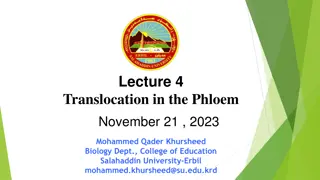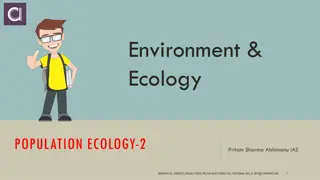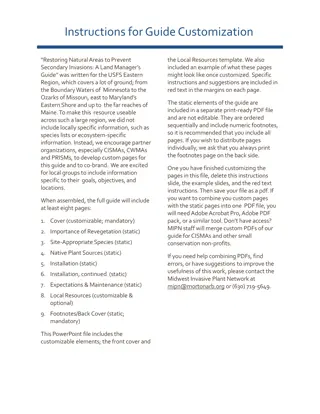Interactions between Ladybird Species in Controlling Aphid Populations
Aphids are pests that parasitize plants and can reproduce rapidly, leading to large populations. Native ladybird species may not effectively control aphid numbers, prompting the introduction of the Harlequin Ladybird. Both ladybird species now compete for food resources, with the Harlequin Ladybird possessing unique features like producing Harmonine for infection resistance. IntraGuild-Predation (IGP) plays a role in their interactions, highlighting the complex dynamics of biological control in ecosystems.
Uploaded on Nov 25, 2024 | 0 Views
Download Presentation

Please find below an Image/Link to download the presentation.
The content on the website is provided AS IS for your information and personal use only. It may not be sold, licensed, or shared on other websites without obtaining consent from the author. Download presentation by click this link. If you encounter any issues during the download, it is possible that the publisher has removed the file from their server.
E N D
Presentation Transcript
IV Southern-Summer School on Mathematical Biology Invasive Species The Ladybird s Tale Group 4 Deborah Fraga Lisette Buding May Anne Mata Sebastian Graiff Thales Kronenberger 1
Aphids are insects that parasite plants (Acyrthosiphon pisum) They are able to reproduce asexually, growing into large populations Within a food-web, Aphids usually are predated by ladybirds such as the Coccinella septempunctata 2
For some regions though, aphids (A) are pests of the crops Native species of ladybugs (C) are not able to control their population size 3
Humans introduced another ladybird species as a biocontrol method, the Harlequin Ladybird (Harmonia axyridis, H) 4
Both ladybird species are now competing for food 5
Both ladybird species are now competing for food 6
IGP 8
IntraGuild-Predation (IGP): the killing and eating of species that use similar, often limiting, resources and are thus potential competitors (Polis et al., 1989) 9
IGP 10
Harmonia axyridis - features H. axyridis (H) is able to produce Harmonine Harmonine increases H resistance against infections H is infected by Nosema thompsoni The infection is not harmful for H, but it is mortal to Coccinella Infection is transmitted through the haemolymph 11
Main question Is the infection an important factor for Harlequin ladybird invasion, considering the IGP with C. septempunctata ? 14
Assumptions of the model Aphids population growth is logistic with a high carrying capacity The other populations suffer from a constant death rate The Egg populations grow from predating aphids, while the Adult populations grow by egg maturation Ladybirds compete for Aphids (food source) Adults hunt aphids with different voracities Infected adult population grows whenever a healthy Harlequin adult eat infected eggs. If an individual of C. septempunctata population eats an egg it dies immediately 15
? = ??.?.(1 ? ? ? ?) ??.?. ? + ???.H ??.?. ? + ???.C ? ?1= ?.? ?1.( ?+??+?) ? = ? .? + ?. ?1.?. ? ? ?2= ?.? ?2.( ?+??+?) ??= ? .?? + ?. ? + ?1.?. ? ??.?.? ? + ??? = ? . ?. + ??.?. + ?.?1.?. + ?.?2.?.? ?1. .(? + ?i + ?) ??.?.? ? + ??? ?= ? . ? ?. ? + ??.?. + ?.?1.??. + ?+ ?.?2.??.? +?.?1.?. ? ?1. ?.(? + ?i + ?) ? = ??.? + ?.? s1.C.hi ? ? = ??.? ?.? + ??.?. ?+???+ ?.?.?2+ ?. .?1.C c.s2.(H + Hi + C) 16
Case 1: Aphids plague Co=1 Ao=1000 17
Case 2: Harlequin spreading Ao=A*=8680 Ho=1 18
Case 3: IGP effect without the infection Co=C* =575 co=c*=122 A0=A*=8680 H=1 19
Case 4: Infection effect, population without healthy Co=C* =575 co=c*=122 A0=A*=8680 Hi=1 20
Case 5: Harlequin used as bio-control for aphids Co=C* =575 co=c*=122 A0=A*=8680 Hi=1 H=100 21
Case 5: Harlequin use as biocontrol for aphids Co=C* =575 co=c*=122 A0=A*=8680 Hi=1 H=100 22
Take home message For a certain set of parameters that reproduces the realistic behaviours, it is not possible for Coccinella septempunctata to survive in the presence of infected Harlequin. 23
References Vilcinskas, A., Stoecker, K., Schmidtberg, H., R hrich, C. R., & Vogel, H. (2013). Invasive harlequin ladybird carries biological weapons against native competitors. Science, 340(6134), 862-863. Vilcinskas, A., Stoecker, K., Schmidtberg, H., R hrich, C. R., & Vogel, H. (2013). Response to Comments on Invasive Harlequin Ladybird Carries Biological Weapons Against Native Competitors . Science, 341(6152), 1342-1342. Stathas GJ, Eliopoulos PA, Kontodimas DC, Giannopapas J. (2001) Parameters of reproductive activity in females of Harmonia axyridis (Coleoptera: Coccinellidae), Eur. J. Entomol. 98 (4): 547-549, 2001 Snyder WE, Sarah B, Joseph RF, Allen JM. (2000) Benefits of Cannibalism for the Lady Beetle Harmonia axyridis (Coleoptera: Coccinellidae) When Prey Quality is Poor. Entomological Society of America. 24
Thank you Questions? 25























